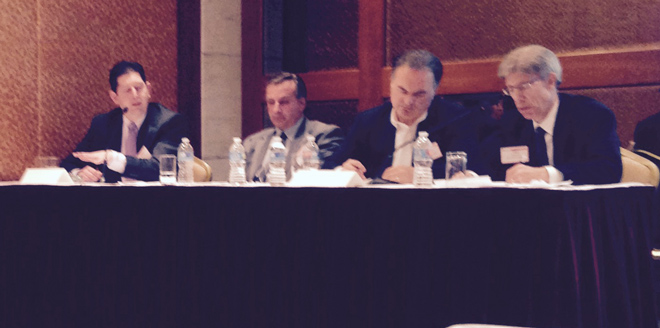By Rich Heidorn Jr.
WASHINGTON — A federal appellate court Friday threw out the Environmental Protection Agency’s 2013 rule exempting diesel generators providing demand response from air emissions limits.
“Because EPA too cavalierly sidestepped its responsibility to address reasonable alternatives, its action was not rational and must, therefore, be set aside,” a three-judge panel of the D.C. Circuit Court of Appeals ruled unanimously in a challenge by Delaware environmental regulators.
At issue is an EPA rule that exempted reciprocating internal combustion engines providing “emergency demand response” from emissions limits for up to 100 hours each year. (National Emission Standards for Hazardous Air Pollutants for Reciprocating Internal Combustion Engines; New Source Performance Standards for Stationary Internal Combustion Engines, 78 Fed. Reg. 6,674, Jan. 20, 2013).
The rule, which replaced a prior 15-hour exemption, noted that using such generators, which are typically powered by diesel fuel, “as part of emergency demand response programs can help prevent grid failure or blackouts.”
Erroneous Assumption
EPA said it loosened the rule based in part on PJM’s comments in a prior rulemaking indicating that resources needed to be available for a minimum of 60 hours annually to participate in the RTO’s emergency load response program.
That was an incorrect conclusion, the court ruled, noting that PJM had clarified in comments to EPA in 2012 that the 60-hour minimum does not apply to individual engines and that engines may be aggregated to meet the 60-hour requirement.
“EPA seems to have either intentionally discounted PJM’s later explanation of its requirement or simply confused the later comment for the earlier one,” the court said. “Another commenter brought the possible confusion to EPA’s attention, but EPA did not specifically respond, saying it considered demand-resource needs ‘in all areas of the country, not just PJM.’ And yet, EPA significantly grounded the 2013 rule in a PJM requirement that does not exist for individual engines.”
EPA had no immediate comment, saying it was still reviewing the court’s decision.
EPA issued the rule under sections 111 and 112 of the Clean Air Act. The Delaware Department of Natural Resources and Environmental Control filed a challenge complaining that emissions from emergency demand response programs significantly worsened ozone pollution in the state and alleging that at least 90% of the pollutants contributing to Delaware’s failure to comply with National Ambient Air Quality Standards come from pollutants transported from other states.
‘Opposite Effect’
Delaware and other challengers, including the Electric Power Supply Association and Calpine, said that demand response based on backup generators was hurting both the environment and grid reliability, counter to EPA’s arguments.
The court summarized the arguments: Because backup generators are exempt from emissions controls, they can underbid conventional generators in capacity markets, resulting in underinvestment by traditional generators, which undermines grid reliability. The reduced power supply increases the number of power emergencies, resulting in an increase in the use of “dirty” backup generators.
“In short, petitioners and the intervenor argue that instead of protecting the nation’s air resources and improving grid reliability as EPA claims, the 2013 rule has the opposite effect.”
PJM’s Independent Market Monitor was among the rule’s critics when it was proposed, telling EPA that the 100-hour exemption would distort both the capacity and energy markets.
“Some have asserted that an exemption for [backup] generators participating in demand-side response programs provides benefits to the organized wholesale electricity markets,” the Monitor wrote. “Those arguments have no merit. On the contrary, providing the exemption will have negative consequences for efficiency and reliability.”
In its comments to EPA, Calpine contended the proposed rule “would incentivize the procurement of diesel-fired [behind-the-meter] generators masquerading as ‘demand response’ in electricity capacity markets and thereby displace clean generating resources.”
Calpine said backup generators are not necessary for reliability in organized markets because “the market will simply procure other resources instead of [a behind-the-meter generator] that has not had to internalize the costs of emissions controls.”
An August 2012 report submitted to EPA by Northeast States for Coordinated Air Use Management, a non-profit association of air quality agencies, said that “demand response programs appear to be shifting a portion of overall electricity demand from traditional generating resources that supply the grid to more dispersed, unregulated diesel generators.”
The court also noted “evidence in the administrative record” that backup generators represent almost 15% of demand response in PJM. PJM officials could not be immediately reached for comment on the ruling.
‘Arbitrary and Capricious’
The court said the rule was arbitrary and capricious because EPA failed to respond to comments raising concerns about its impact on the grid or to those suggesting that the 100-hour limit was based on faulty evidence.
“EPA also did not consider the alternative of limiting the exception to parts of the country not served by organized capacity markets. We should further note that EPA did not obtain the views of [the Federal Energy Regulatory Commission} or [the North American Electric Reliability Corp.] on the reliability considerations upon which EPA based the exemption.”
The court also criticized EPA for providing contradictory answers when challenged. It said that the agency dismissed suggestions that it work with FERC on the reliability impact of the rule, contending that the rule’s purpose was to address emissions and that it was not its responsibility “to determine which resources are used for grid reliability.”
“EPA cannot have it both ways,” the court said. “It cannot simultaneously rely on reliability concerns and then brush off comments about those concerns as beyond its purview.”
In reversing the 100-hour exemption, the court said EPA can file a motion requesting either that the current standards remain in place or that it be allowed time to develop interim standards “if vacating these portions of the 2013 rule will cause administrative or other difficulties.”





